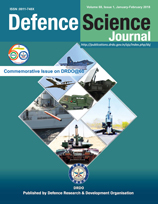Activated Carbon Fabric: An Adsorbent Material for Chemical Protective Clothing
DOI:
https://doi.org/10.14429/dsj.68.11734Keywords:
Activated carbon fabric, Adsorption, Viscose rayon precursor, Chemical protection, Carbonisation, ActivationAbstract
Activated carbon fabric or fiber (ACF) is a novel carbonaceous material with exceptionally high adsorption rate and larger adsorption capacity, that has emerged as a rising star in the field of adsorbents. ACF has many advantages over other commercial porous storage materials such as granular activated carbon and powdered activated carbon in terms of adsorption capacity, well defined microporous structure, stability, flexibility and ease of lamination to various substrates. In the last few years, activated carbon fabrics have gained greater choice of interest for use as an adsorbent material in several fields including nuclear, biological and chemical (NBC) protection suit. Viscose rayon, acetate, polyacrylonitrile, pitch, and phenolic based materials are mainly used as precursors for preparation of ACF. ACF or fibres are generally prepared by process comprising stabilisation, carbonisation and activation of precursors. Reviews recent advances and developments in the field of ACF and their utility as an adsorbent material in various fields including NBC scenario. ACF with unmatchable pore structure and surface characteristics at present, with continued innovations and attention to its key challenges, it is expected that ACF will play a pivotal role in diverse environmental, defence, and civil applications.
Downloads
Published
How to Cite
Issue
Section
License
 Where otherwise noted, the Articles on this site are licensed under Creative Commons License: CC Attribution-Noncommercial-No Derivative Works 2.5 India
Where otherwise noted, the Articles on this site are licensed under Creative Commons License: CC Attribution-Noncommercial-No Derivative Works 2.5 India


